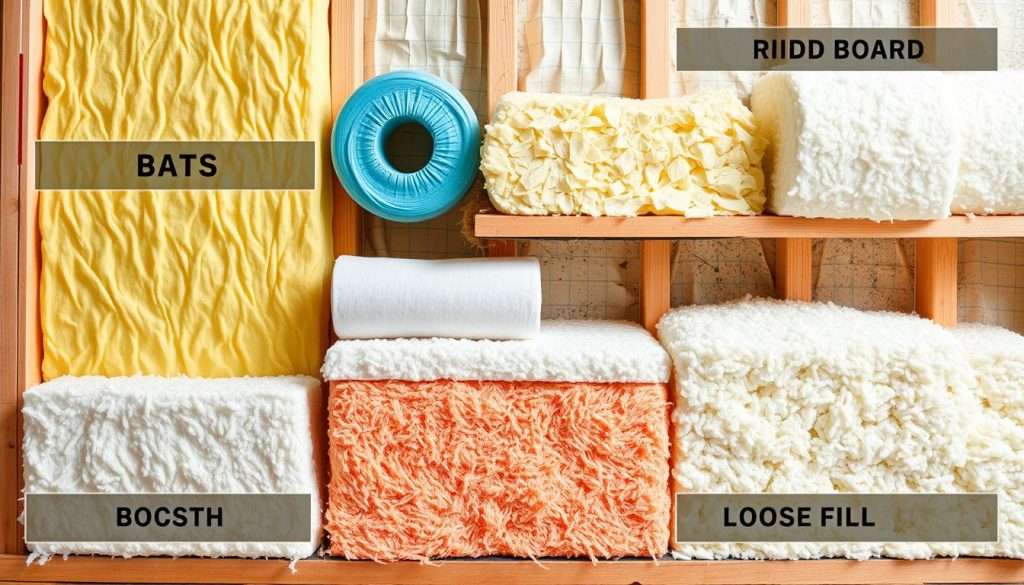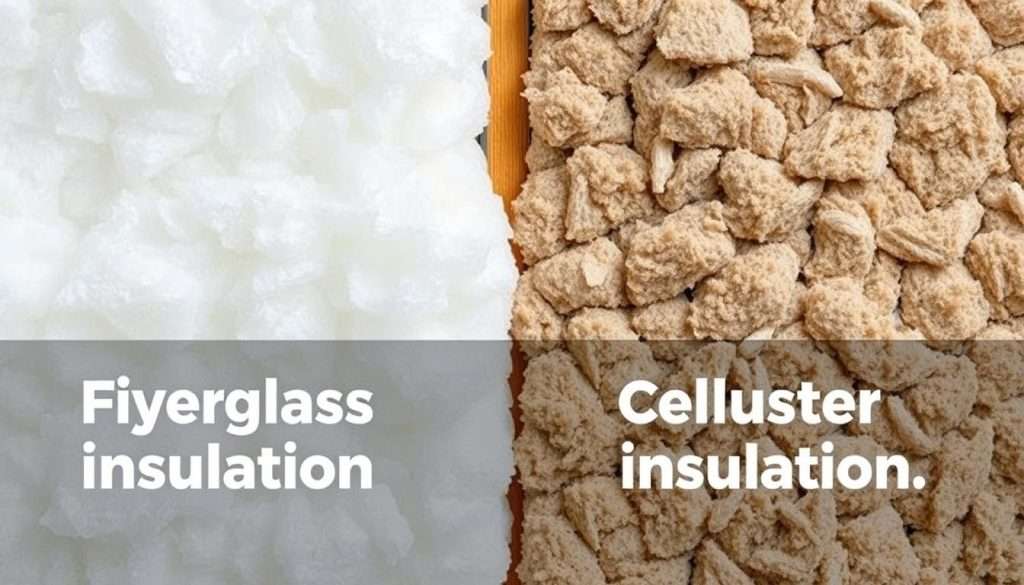Homeowners need to know about fiberglass insulation to make their homes better. It’s made of tiny glass fibers that keep air in. This helps block heat and makes homes more comfortable and energy-efficient.
But, fiberglass insulation also has downsides. We’ll explore its good and bad points in this guide. You’ll learn about its types, benefits, and how to take care of it.
Key Takeaways
- Fiberglass insulation is a widely used home insulation material.
- Its properties help in maintaining indoor temperature effectively.
- Understanding its advantages can lead to significant energy savings.
- Be aware of the potential disadvantages when considering installation.
- Various types of fiberglass insulation are available for different needs.
Introduction to Fiberglass Insulation
Knowing about fiberglass insulation is key for homeowners wanting to save energy. It’s made from glass fibers woven into batts, rolls, or loose-fill. It keeps your home warm in winter and cool in summer.
The fiberglass insulation properties trap air well. This makes it a poor heat conductor. It’s great at keeping your home comfortable.
What Is Fiberglass Insulation?
Fiberglass insulation is used in homes and buildings. It’s made of tiny glass fibers. It’s good at keeping heat out.
It comes in different types for different places in your home. It helps make your home more comfortable.
How Does It Work?
Fiberglass insulation works by trapping air. Air doesn’t conduct heat well. This helps keep your home at a steady temperature.
When installed right, it blocks heat flow. This can save a lot of energy. Knowing how it works shows its value in your home.
| Property | Description |
|---|---|
| Thermal Resistance | Reduces heat flow, keeping spaces comfortable. |
| Sound Absorption | Minimizes noise transmission between rooms. |
| Fire Resistant | Does not burn quickly, providing safety. |
| Moisture Resistant | Less prone to mold growth compared to other materials. |
| Versatile Installation | Available in various forms for different applications. |
Benefits of Fiberglass Insulation
Fiberglass insulation does more than just keep you warm. It’s good for your wallet and your home. Let’s look at what makes it so great.
Energy Efficiency
Fiberglass insulation is very good at saving energy. It helps lower your bills for heating and cooling. This is because it stops heat from moving around too much.
So, your home stays comfy all year. And you save money on your bills.
Noise Reduction
Fiberglass insulation also makes your home quieter. It absorbs sound, making your home peaceful. This is great for homes near busy roads or with lots of noise.
With it, you can relax more easily. Your home will feel calmer.
Fire Resistance
Fiberglass insulation is also safe from fires. It doesn’t catch fire easily. This means it can slow down fires, giving you more time to get out.
Choosing this insulation makes your home safer. It’s a smart choice for keeping your family safe.
| Benefit | Description |
|---|---|
| Energy Efficiency | Reduces heating and cooling costs by minimizing heat transfer. |
| Noise Reduction | Absorbs sound waves for a quieter indoor environment. |
| Fire Resistance | Non-combustible, slows the spread of flames, enhancing safety. |
Types of Fiberglass Insulation
It’s important to know about different fiberglass insulation types. Each one has its own use, making sure your project works well. Let’s explore the most common types.
Batts and Rolls
Batts and rolls fit easily into standard wall spaces. They’re great for new buildings or when fixing up old ones.
- Easy to install in open walls.
- Available in various thicknesses and R-values.
- Provides effective thermal resistance.
Loose-fill Insulation
Loose-fill insulation is perfect for odd-shaped spaces, like attics or around pipes. It fills in hard spots well, making your insulation better.
- Ideal for retrofitting older homes.
- Can be blown in for a snug fit.
- Great for soundproofing as well.
Rigid Board Insulation
Rigid board insulation is strong for places needing extra support, like basements or exterior walls. It keeps warm in and cold out, and it resists moisture.
- Available in various thicknesses for different applications.
- Lasts longer than some flexible options.
- Effective for both thermal insulation and structural support.

Installation Methods
Knowing how to install fiberglass insulation is key for the best results. You can do it yourself or hire a pro. We’ll talk about DIY tips, when to get help, and mistakes to avoid.
DIY Installation Tips
Trying to install fiberglass yourself can be fun and rewarding. Here are some important tips:
- Gather the right tools: You’ll need utility knives, measuring tape, and a straight edge for cuts.
- Wear protective gear: Use gloves, goggles, and a mask to avoid irritation from fiberglass.
- Measure accurately: Make sure to measure spaces well to avoid waste and ensure a good fit.
- Follow manufacturer instructions: Each product has its own special needs for best results.
When to Hire a Professional
There are times when you should get a pro for fiberglass insulation. Consider a pro if you face these situations:
- Large spaces: Pros can work faster and more accurately in big areas.
- Complex structures: Unique buildings might need special skills.
- Lack of time: If you’re short on time, a pro can do it quicker without sacrificing quality.
Common Mistakes to Avoid
Staying away from common mistakes can make your insulation job better. Here are some mistakes to avoid:
- Ignoring safety precautions: Always wear safety gear to avoid health risks from fiberglass.
- Underestimating or overestimating the material needed: Get the right amount to avoid waste and ensure a good fit.
- Insufficient sealing: Make sure to seal seams and edges well to avoid air leaks and keep energy in.
- Neglecting existing insulation: Don’t add too much fiberglass on top of old insulation, as it can cause moisture problems.
| Aspect | DIY Installation | Professional Installation |
|---|---|---|
| Cost | Generally lower, but depends on materials | Higher due to labor costs |
| Time | Can take longer depending on experience | Quicker due to expertise |
| Skill Level | Requires basic tools and safety knowledge | Professional training and experience |
| Quality of Work | Varies with experience | High-quality assurance with warranties |
R-Value and Its Importance
The R-value is key in insulation, showing how well it stops heat. Knowing this helps homeowners choose wisely for energy savings. With fiberglass insulation, you can see how it blocks heat flow. A higher R-value means better insulation, making homes cozy and saving money.
Understanding R-Value
R-value is measured by inch for different insulations. Materials like fiberglass, cellulose, and spray foam have different R-values. The right R-value mix is crucial for good insulation. Fiberglass is often picked for its good price and performance.
How to Choose the Right R-Value
Choosing the right R-value depends on where you live and the weather. R-values change by region to keep homes energy-efficient. For more on picking the right R-value, check this resource. Here’s a quick guide for different home areas:
| Area | Recommended R-Value |
|---|---|
| Attic | 30 – 60 |
| Walls | 13 – 21 |
| Crawlspace | 19 – 30 |
Fiberglass Insulation vs. Other Insulation Materials
Choosing the right insulation for your home is important. You need to know about fiberglass, spray foam, and cellulose. Each has its own benefits and drawbacks. Fiberglass is affordable and easy to install. Spray foam seals air well, but costs more. Cellulose is eco-friendly but has a lower R-value.
Comparison with Spray Foam
Fiberglass and spray foam have different strengths and weaknesses. Here are some key points:
- R-Value: Spray foam has a higher R-value, meaning it keeps your home warmer for less space.
- Air Sealing: Spray foam seals gaps better than fiberglass, keeping air out.
- Cost: Fiberglass is cheaper, making it good for big projects.
- Installation: Fiberglass is easy for DIY, but spray foam needs a pro.
Comparison with Cellulose
Fiberglass and cellulose have different qualities and eco-friendliness:
| Feature | Fiberglass Insulation | Cellulose |
|---|---|---|
| Material Composition | Glass fibers | Recycled paper products |
| R-Value | Higher R-value, around 2.9 to 3.8 per inch | Lower R-value, approximately 3.0 to 3.5 per inch |
| Environmental Impact | Non-renewable but recyclable | Made from recycled materials, biodegradable |
| Moisture Control | Resistant to moisture | Can absorb moisture, requiring careful management |

Health and Safety Considerations
It’s important to know how to stay safe when working with fiberglass insulation. This material is often used to keep homes warm. But, it can also pose some risks. Knowing how to protect yourself can make working with fiberglass safer.
Potential Risks of Fiberglass
Working with fiberglass can lead to health problems. Some common issues include:
- Skin Irritation: Fiberglass can cause rashes or irritation on your skin.
- Respiratory Problems: Breathing in fiberglass fibers can cause breathing issues or worse health problems.
- Eye Irritation: Fiberglass can irritate your eyes, making them red or uncomfortable.
Personal Protective Equipment Recommendations
Wearing the right protective gear is key to staying safe. Here are some must-haves:
- Gloves: Latex or nitrile gloves protect your hands from irritation.
- Respirators: A mask or respirator filters out harmful fiberglass particles in the air.
- Goggles: Goggles keep your eyes safe from irritation caused by flying fibers.
By using these protective items, you can make your work area safer. This is good for you and everyone around you.
| Risk | Symptoms | PPE Recommendations |
|---|---|---|
| Skin Irritation | Rashes, redness | Gloves |
| Respiratory Problems | Coughing, difficulty breathing | Respirators |
| Eye Irritation | Redness, discomfort | Goggles |
Maintenance of Fiberglass Insulation
Keeping your fiberglass insulation in good shape is key. Look for damage and clean it right to keep it working well. This guide will show you how to care for your insulation.
Inspecting for Damage
Check your insulation often to spot problems early. Look for:
- Wet spots that mean water got in
- Mold growth in damp places
- Physical damage like torn batts
- Odors that mean something’s wrong
Fixing damage fast keeps your insulation working right.
Proper Cleaning Techniques
Cleaning your insulation is important. Use these methods to clean it well:
- Use a vacuum with a HEPA filter to get rid of dust.
- Don’t use water or chemicals to avoid mold.
- Check vents and insulation edges for dust.
These cleaning steps will help your insulation last longer and work better.
| Inspection Item | Description | Recommended Action |
|---|---|---|
| Wet Spots | Moisture on insulation surfaces | Investigate and repair water leaks |
| Mold Growth | Visible mold on insulation material | Remove insulation if heavily infested, treat area |
| Physical Damage | Torn batts or compressed areas | Replace damaged insulation |
| Odors | Unusual or musty smells | Inspect area for mold or water damage |
Conclusion
Fiberglass insulation is a smart choice for your home. It makes your home more energy efficient and comfortable. Knowing the different types and how to install them helps you choose the best.
Understanding R-value is key. It helps you pick the right insulation. This way, you save money and keep your home cozy.
Key Takeaways
Fiberglass insulation saves energy and makes your home quieter and safer. There are batts, loose-fill, and rigid boards for different needs. Choosing the right one is important.
Deciding to do it yourself or hire a pro can save you money. It’s all about knowing when to act.
Final Thoughts on Fiberglass Insulation
Getting fiberglass insulation is a smart choice for your home. It makes your home warm and saves energy. With the right info, you can improve your home’s insulation.
Think about the cost and long-term benefits. This helps you make smart choices for your home.
